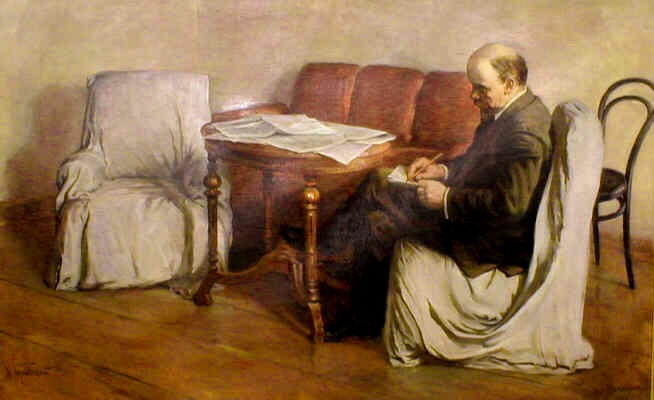Brodski drawing Lenin at the 3rd Congress of Komintern, Moscow 1921.
Brodski drawing Lenin at the
3rd Congress of Komintern, Moscow 1921.
Born in Sofievka, Ekaterinoslav pr
(Ukraine), 1883(1884). Studied at Odessa Drawing
School/Art College 1896(95?)-1902; Imperial ACADEMY OF ARTS 1902-08.
Active in
St.Petersburg/Petrograd/Leningrad (travelled in Western Europe
1909-11). Began exhibiting
1904. Member of UNION OF RUSSIAN ARTISTS from 1910; KUINDZHI SOCIETY
1910s; AKhRR 1923-28.
Exhibited with Imperial ACADEMY OF ARTS 1904-16; UNION OF RUSSIAN
ARTISTS 1907-18; MOLKh
1908-09; WORLD OF ART 1911; TYuRKh; ITINERANTS 1914, 1916; COMMUNE OF
ARTISTS 1920s; AKhRR
1925-28, REPIN SOCIETY; KUINDZHI SOCIETY 1929. Important shows include
first IZDEBSKI
SALON 1909-10; "ARTISTS OF THE RUSSIAN FEDERATION OVER FIFTEEN YEARS";
Leningrad, 1932; "ARTISTS OF THE RUSSIAN FEDERATION OVER FIFTEEN
YEARS", Moscow,
1933; "Fifteen Years of the Workers' and Peasants' Red Army", Moscow,
1933;
"Twenty Years of the Workers' and Peasants' Red Army", Moscow, 1938;
"INDUSTRY OF SOCIALISM", Moscow, 1939. Specialised in landscapes and
portraits
before October 1917 revolution; painted many portraits of the political
leaders 1920s-30s.
Well-known works include The ceremonial Opening of the IInd
Congress of the IIIrd
KomIntern (1920-24; Historical Museum, Moscow); "The
execution by Firing-Squad
of the 26 Baku Commissars (1925; Baku Art Museum); several
pictures of Lenin, notably Lenin
in Smolny (1930; Historical Museum Moscow); Portrait
of Gorki (1937; Tretyakov
Gallery). Taught at INSTITUTE OF PAINTING, SCULPTURE AND ARCHITECTURE
1932-39 (rector
1934-39). Awarded order of Lenin 1934. Decorated festivals in Petrograd
1918.
Officially-celebrated first-wave socialist realist painter; exponent of
a highly-finished
style; one of three painters who took tea with Stalin in summer of
1933; assembled a large
collection of Russian and West European art. Died in Leningrad 1939.
(Matthew Cullerne Bown: Russian and Soviet
Painters. Ilomar, London)
"Vladimir Ilich Lenin", oil on cardboard, 1924.
Brodsky was a forefather of
Socialist Realism, famous for his iconic portayals of Lenin
and his idealized, carefully crafted paintings dedicated to the events
of the Civil War
and Bolshevik Revolution of 1917. From 1902 to 1908, he studied with
the great genre and
history painter Ilya Repin at the Imperial Academy of Arts in St.
Petersburg. Brodsky was
known before the Revolution for his observant salon portraits and
landscapes, exhibiting
from 1904 with the Wanderers and the World of Art. Throughout his
career, he maintained
the academy standards he absorbed as a student; thus he was able to
reinstate tradtional
methods and style s of painting at he reformed All-Russian Academy od
Arts, Leningrad.
Throughout his career, Brodsky openly acknowledged his Jewish heritage,
and he was briefly
involved in activities of the Jewish renaissance. In 1916, he became a
member of the
Jewish Society for the Encouragement of the Arts in Petrograd,
contributing to both the
Petrograd Exhibition of Jewish Artists and the
Moscow Exhibition of Paintings
and Sculpture by Jewish Artists in 1917-18. Mentioning
incidents of pre-Revolution-ary
anti-Semitism in his memoirs, he achnowledged the Soviet regime for
recognizing him and
his work. A member of AKhRR from 1924 through 1928, Brodsky painted
numerous sympathetic
portraits of Lenin from life and had no difficulty conforming to
Bolshevik
dictates.Ambitious in scale, composition, and theme, these portraits
were regarded as
landmarks. Their meticulous execution, based on research, sketches from
life, and
documentary photographs (a technique labeled "Brodsky-ism" by the
artist's
critics) caused Brodsky to be ejected from the AKhRR even though he was
highly regarded by
Stalin and members of the arts administration. During the 1930s he
contributed to numerous
exhibitions and had several solo shows. In 1932, Brodsky was named
Honored Arts Worker of
the RSFSR. He was named Professor (1932-39) and then - his final
accolade - Director
(1934-39) of the All-Russian Academy od Arts, Leningrad. In 1933,
Brodsky was invited to
join Alexander Gerasimov and Katsman to meet with Stalin and Kliment
Voroshilov to discuss
the Socialist Realist method. In 1937, Brodsky won a gold medal at the
exposition
Universelle in Paris. In 1949, his apartment was opened as a memorial
museum.
(Russian Jewish Artists in a Century of
Change 1890 - 1990", edited by
S.T.Goodman, Prestel, Munich-New York, 1996)
See
also:
Hans Dollinger: "Rußland", C.Bertelsmann, München
1977.
Dawn Ades and others: "Kunst und Macht im Europa der Diktatoren 1930 -
1945", Oktagon - Verlag, 1996.
S.T.Goodman (editor): "Russian Jewish Artists in a Century of Change
1890 -
1990", Prestel, Munich-New York, 1996.
Marc Scheps (editor): "Unser Jahrhundert"; Prestel,
München-New York,
1996.
Meyers Taschen-Lexikon, B.I.-Taschenbuchverlag,
Mannheim-Leipzig-Wien-Zürich,
1995.

"Vladimir Ilich Lenin at the Smolny
Institute", oil on canvas, 100 x 160 cm.
Copy of the famous Brodsky-painting by Grigori Efimovich Shpolyanski.
Signature of the artist